What’s Hard About Mars?

What’s hard about Mars?
Mars, unlike the Moon, is far away. It also has an atmosphere - but not a useful one. Atmospheric density, wind, dust storms… all of these things contribute to a larger list of circumstances that any given mission needs to be ready for.
All those circumstances contribute heavily to the cost, time and hard resources needed to be poured into the mission preparation. In addition, the vast distance to Mars means the cost of carrying all this prepared hardware must be covered.
The atmosphere of Mars is such that if you’re going too fast during entry, you’ll burn up. It’s such a low density however that parachutes aren’t tremendously useful.
During the Curiosity rover’s landing it needed a heat shield, a supersonic parachute, rocket boosters to slow it down, a sky-crane to allow Curiosity to drop to the surface like an interplanetary spider and then explosive propulsion to send the platform it dropped from a safe distance away to crash into the surface.
During this landing, the rover experienced a force of about 15 g’s. That force would make a 200 lb man weigh 3000 lbs. Without proper precautions it would make the average head snap down at about 150 to 165 lbs.
NASA’s developing a new type of parachute and it’s being attached to a flying saucer-like spacecraft known as the Low-Density Supersonic Decelerator. This is currently hoped to provide NASA with a stable go-to architecture for future Mars missions.
The red planet’s killed most missions sent there. Power for solar-panels on rovers get covered during planet-wide dust storms. Some missions smashed into its moons. Some have smashed into its surface. Others have simply missions the planet entirely only to drift away as Mars dances around the Sun.
The world is an untamed place and has sought to buck all attempts to temper its mysteries.
(Image credit: ESA / DLR / FU Berlin (G. Neukum) / animation by Emily Lakdawalla)
More Posts from Maevetheeuropan and Others
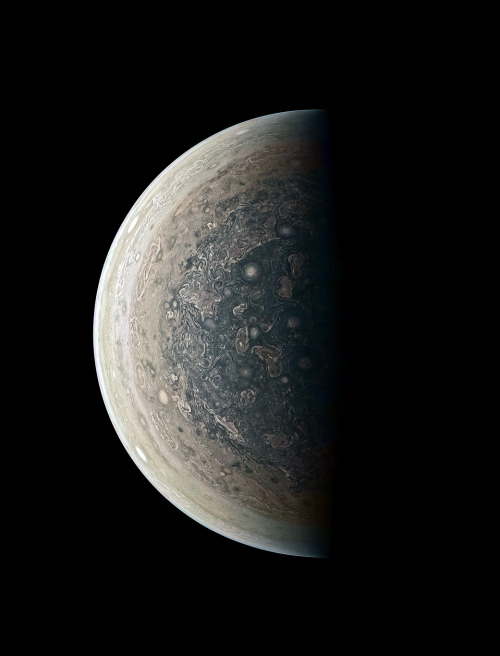
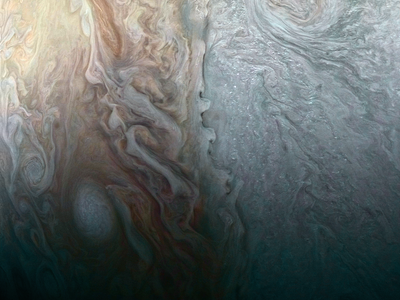



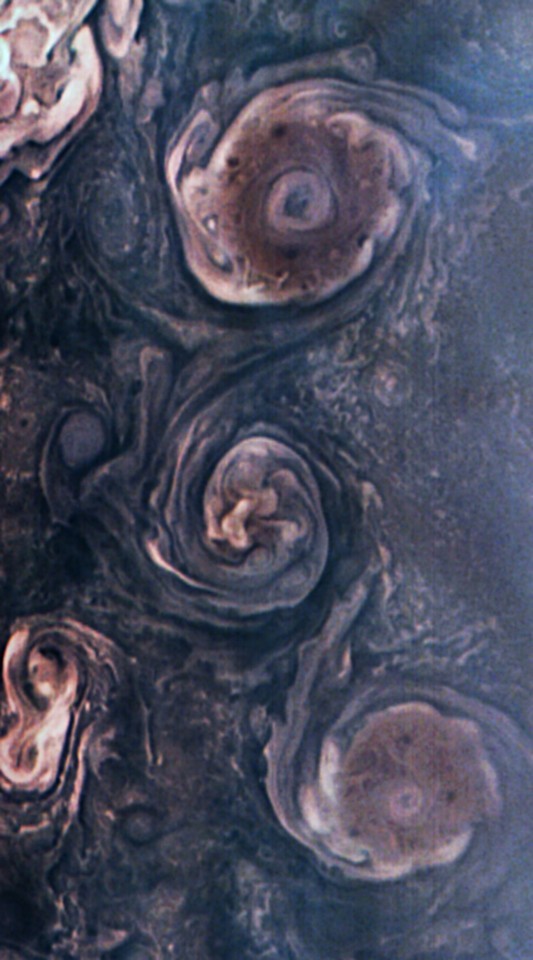



Images of Jupiter taken by JunoCam on NASA’s Juno spacecraft.

Mission Juno
Juno is a NASA spacecraft. It is exploring the planet Jupiter. Juno launched from Earth in 2011. It reached Jupiter in 2016. That was a five-year trip!
The name “Juno” comes from stories told by the Romans long ago. In the stories, Juno was the wife of Jupiter. Jupiter hid behind clouds so no one could see him causing trouble. But Juno could see through the clouds.
Juno has science tools to study Jupiter’s atmosphere. (The atmosphere is the layer of gases around a planet.) Juno will take the first pictures of Jupiter’s poles. The spacecraft will study the lights around Jupiter’s north and south poles, too.
Juno will help scientists understand how Jupiter was made. The spacecraft will help them learn how Jupiter has changed, too. The new discoveries can help us understand more about our solar system.
Sound of Jupiter’s Magnetosphere: Click here
Credit: NASA / JPL-Caltech / Mission Juno / Jason Major / Luca Fornaciari / Gerald Eichstädt









Images of Jupiter taken by JunoCam on NASA’s Juno spacecraft.

Mission Juno
Juno is a NASA spacecraft. It is exploring the planet Jupiter. Juno launched from Earth in 2011. It reached Jupiter in 2016. That was a five-year trip!
The name “Juno” comes from stories told by the Romans long ago. In the stories, Juno was the wife of Jupiter. Jupiter hid behind clouds so no one could see him causing trouble. But Juno could see through the clouds.
Juno has science tools to study Jupiter’s atmosphere. (The atmosphere is the layer of gases around a planet.) Juno will take the first pictures of Jupiter’s poles. The spacecraft will study the lights around Jupiter’s north and south poles, too.
Juno will help scientists understand how Jupiter was made. The spacecraft will help them learn how Jupiter has changed, too. The new discoveries can help us understand more about our solar system.
Sound of Jupiter’s Magnetosphere: Click here
Credit: NASA / JPL-Caltech / Mission Juno / Jason Major / Luca Fornaciari / Gerald Eichstädt
Space Station Research: Cardiovascular Health
Each month, we highlight a different research topic on the International Space Station. In February, our focus is cardiovascular health, which coincides with the American Hearth Month.
Like bones and muscle, the cardiovascular system deconditions (gets weaker) in microgravity. Long-duration spaceflight may increase the risk of damage and inflammation in the cardiovascular system primarily from radiation, but also from psychological stress, reduced physical activity, diminished nutritional standards and, in the case of extravehicular activity, increased oxygen exposure.

Even brief periods of exposure to reduced-gravity environments can result in cardiovascular changes such as fluid shifts, changes in total blood volume, heartbeat and heart rhythm irregularities and diminished aerobic capacity.

The weightless environment of space also causes fluid shifts to occur in the body. This normal shift of fluids to the upper body in space causes increased inter-cranial pressure which could be reducing visual capacity in astronauts. We are currently testing how this can be counteracted by returning fluids to the lower body using a “lower body negative pressure” suit, also known as Chibis.
Spaceflight also accelerates the aging process, and it is important to understand this process to develop specific countermeasures. Developing countermeasures to keep astronauts’ hearts healthy in space is applicable to heart health on Earth, too!

On the space station, one of the tools we have to study heart health is the ultrasound device, which uses harmless sound waves to take detailed images of the inside of the body. These images are then viewed by researchers and doctors inside Mission Control. So with minimal training on ultrasound, remote guidance techniques allow astronauts to take images of their own heart while in space. These remote medicine techniques can also be beneficial on Earth.
Make sure to follow us on Tumblr for your regular dose of space: http://nasa.tumblr.com
Everyone knows that, in space, no one can hear you scream. Sound is a wave that requires a medium to travel through, and if space is empty, there’s no medium to carry that sound. Except, as Mike from The Point Studios explains, empty is a relative term. Space is full of dust and gas and plasma, just not as full of that matter as we’re used to. Thus, the question of whether sound can travel through space turns into a matter of scale. If the scale–the wavelength–of a sound is much larger than the distance between molecules, then the sound can propagate. So there CAN be sound in space – it just has to have a very long wavelength and, thus, a very low frequency. Check out the video for the full story! (Video credit: The Point Studios)

NASA Wants Deep Space Habitat Ideas
How will humans live on Mars? Well, NASA’s not really sure yet, but if you’ve got any ideas you can submit them now. The agency has just put out a call for proposals for “deep space habitation prototypes.”
from NASA’s press release:
NASA is soliciting proposals for the development of prototypes for deep space habitats that will give astronauts a place to call home during long-duration missions supporting the agency’s Journey to Mars.

That looks pretty damn cool.
(via The World’s First ‘Marschitect’ Is Laying the Groundwork for Architecture in Space — How We Get To Next)

What caused this outburst of this star named V838 Mon? For reasons unknown, this star’s outer surface suddenly greatly expanded with the result that it became the brightest star in the entire Milky Way Galaxy in January 2002. Then, just as suddenly, it faded. A stellar flash like this had never been seen before – supernovas and novas expel matter out into space.
Although the V838 Mon flash appears to expel material into space, what is seen in the above GIF from the Hubble Space Telescope is actually an outwardly moving light echo of the bright flash.
In a light echo, light from the flash is reflected by successively more distant rings in the complex array of ambient interstellar dust that already surrounded the star. V838 Mon lies about 20,000 light years away toward the constellation of the unicorn (Monoceros), while the light echo above spans about six light years in diameter.
Credit: NASA, ESA
To discover more, visit: https://www.nasa.gov/multimedia/imagegallery/image_feature_2472.html
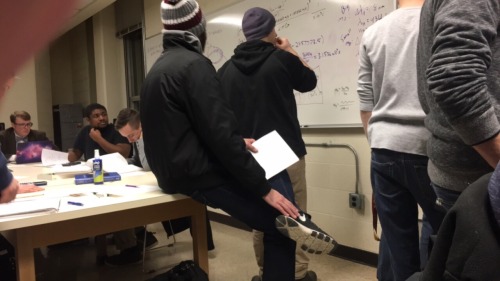
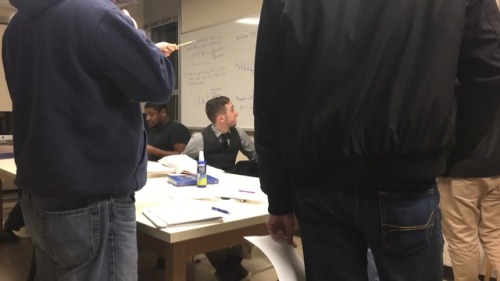
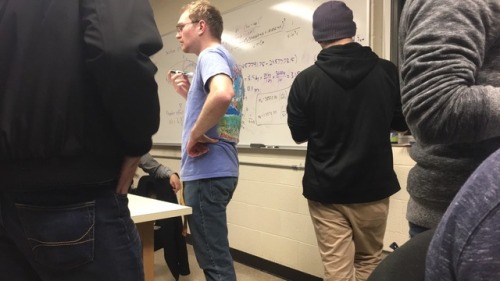
The beautiful chaos of watching 12 frantic astrophysics students try to save a theoretical astronaut from falling into a black hole. I’ve never seen a group of people work so quickly and efficiently before.

It’s super shitty quality but here it is!


Elon Musk wants to put people on Mars in less than a decade
Musk has already said he wants SpaceX to start sending unmanned missions to Mars in 2018. He has even planned out the details of the future expeditions.
Follow @the-future-now
-
 pandepulque liked this · 6 years ago
pandepulque liked this · 6 years ago -
 jadedsatedkitten reblogged this · 7 years ago
jadedsatedkitten reblogged this · 7 years ago -
 maevetheeuropan reblogged this · 8 years ago
maevetheeuropan reblogged this · 8 years ago -
 maevskaya reblogged this · 9 years ago
maevskaya reblogged this · 9 years ago -
 twistedsickminded reblogged this · 9 years ago
twistedsickminded reblogged this · 9 years ago -
 steelskyline reblogged this · 9 years ago
steelskyline reblogged this · 9 years ago -
 nycbugman liked this · 9 years ago
nycbugman liked this · 9 years ago -
 nanographics liked this · 9 years ago
nanographics liked this · 9 years ago -
 starsaremymuse reblogged this · 9 years ago
starsaremymuse reblogged this · 9 years ago -
 literally-socks reblogged this · 9 years ago
literally-socks reblogged this · 9 years ago -
 literally-socks liked this · 9 years ago
literally-socks liked this · 9 years ago -
 420powell liked this · 9 years ago
420powell liked this · 9 years ago -
 reading-writing-revolution reblogged this · 9 years ago
reading-writing-revolution reblogged this · 9 years ago -
 reading-writing-revolution liked this · 9 years ago
reading-writing-revolution liked this · 9 years ago -
 rigs83-stuff liked this · 9 years ago
rigs83-stuff liked this · 9 years ago -
 thatukp-body reblogged this · 9 years ago
thatukp-body reblogged this · 9 years ago -
 mountain-dews-blog reblogged this · 9 years ago
mountain-dews-blog reblogged this · 9 years ago -
 starsaremymuse reblogged this · 9 years ago
starsaremymuse reblogged this · 9 years ago -
 pumpkinpieeatyoface reblogged this · 9 years ago
pumpkinpieeatyoface reblogged this · 9 years ago -
 katatsumuli reblogged this · 9 years ago
katatsumuli reblogged this · 9 years ago -
 swizzlevixen liked this · 9 years ago
swizzlevixen liked this · 9 years ago -
 stinkytwst liked this · 9 years ago
stinkytwst liked this · 9 years ago -
 free-raccoon-eyes liked this · 9 years ago
free-raccoon-eyes liked this · 9 years ago -
 foxjevilwild liked this · 9 years ago
foxjevilwild liked this · 9 years ago -
 tea-party-of-the-dead liked this · 9 years ago
tea-party-of-the-dead liked this · 9 years ago -
 vitanonestsatis liked this · 9 years ago
vitanonestsatis liked this · 9 years ago -
 missjamiekaye liked this · 9 years ago
missjamiekaye liked this · 9 years ago -
 shotfromguns liked this · 9 years ago
shotfromguns liked this · 9 years ago -
 tinsnip reblogged this · 9 years ago
tinsnip reblogged this · 9 years ago -
 the-nomadic-writer liked this · 9 years ago
the-nomadic-writer liked this · 9 years ago -
 driedfrogpills4me reblogged this · 9 years ago
driedfrogpills4me reblogged this · 9 years ago -
 traumschwinge reblogged this · 9 years ago
traumschwinge reblogged this · 9 years ago -
 cynic-in-green liked this · 9 years ago
cynic-in-green liked this · 9 years ago -
 scienc5life reblogged this · 9 years ago
scienc5life reblogged this · 9 years ago -
 jennifermoriarta liked this · 9 years ago
jennifermoriarta liked this · 9 years ago -
 blasteinagogo liked this · 9 years ago
blasteinagogo liked this · 9 years ago -
 cosmemer-archive liked this · 9 years ago
cosmemer-archive liked this · 9 years ago